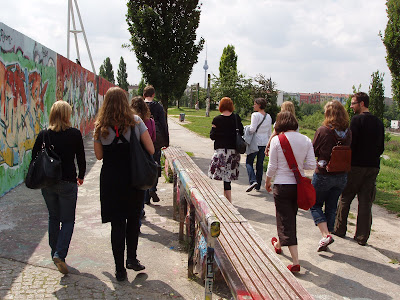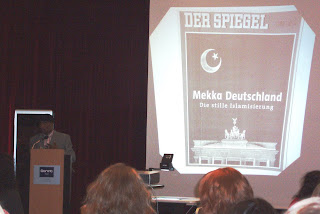
Religion, antisemitism, antiislamicism (permit me to make up a word) and integration were the topics of the day. They overlapped somewhat in the various presentations but each topic presents it’s own varied problems.
Our first speaker was Mr. Tim Jensen, a lecturer at the university of Copenhagen with a specialty in the history of religion. As an atheist he views himself to be in the religious minority in Denmark and it is from that context that he presented a challenging analysis of the majority Christian religion of Denmark. As a good historian he began with some background information, telling us that of Denmark’s 100 registered minority religions, 3/4 of them were Christian, and that of those who actually practice the religion they identify with, only a minuscule minority probably 1 or 2 percent or the population practice a non-Christian religion. Now this is certainly a surprising number considering the firestorm of anti-immigrant sentiment in this country, but to me the more shocking thing is that Denmark has “registered religions.”
The state here actually controls who can be a registered leader of a religious group and the state still funds the majority Lutheran/Peoples church. Additionally, the government has a minister of ecclesiastical affairs and levies taxes to pay for the church’s administration. How does this work? How is it that the overwhelmingly secular Danish society support this? Mr. Jensen’s answer is that the Danes have a special kind of religion, they actually are Christian, even if they don’t go to church, because they choose to pay taxes to support the church. In fact some 83 percent of the population are paying members of the People’s Church! Mr. Jensen assured us that the Danes like their money to be theirs, so for them to be willing to pay for the church means they actually support the church. He also offered an interesting view of liberal Christianity in the Danish context that helped explain this paradox further. Even though the Danes may not look like a Christian society by American standards, (i.e. they don’t go to church, profess faith, talk about God, believe Jesus is the son of God and so on...) they do think of themselves as more enlightened or refined Christians, their religion is private and dignified, so much so that they don’t even need to go to Church. So, in Mr. Jensen’s words, the Danes want the church to be on the hill or the corner, a familiar and comforting institution, but they don’t need to actually use the Church.
Mr. Jensen tried to explain this by saying that the Church has been present in Danish society for 1000 years, and has slowly brainwashed the population. My analysis is that if the Church is willing to be controlled by the state through approval of it’s clergy, and paid for by taxing a non-believing population, the Church itself has been secularized right along with Danish society.

The second speaker of the day was less challenging personally, but certainly quite interesting. Mrs. Cecilia Felicia Stockholm Banke, a journalist and academic who’s studies focused on anti-religious sentiment in Denmark and Europe, gave us a brief lecture on antisemitic and antimuslim attitudes in Denmark. Considering the Danes role in rescuing their Jewish populations in WWII, the recent emergence of antisemitic attitudes in Denmark is rather disturbing. Mrs. Banke helped us to grasp the complexity of the situation and fostered a good discussion among our group. Her work focused on elementary education on the Holocaust and it was through that lense that we analyzed antisemitism. It seems that among all Danes, including immigrants, there is an understanding of the horrors of the Holocaust, but when it comes to current views on Jews, there is an emerging antisemitism that seems to be tied to the State of Israel and the Palestinian conflict. Animosity and fear of the Israeli state has turned itself into extreme positions, typified by the famous denial of the Holocaust by the higher-ups in Iran, and also reflected to a lesser extent in some of Denmark’s immigrant school children. It would seem that antimuslim attitudes in the general population also lend fuel to the fire of antisemitism in some immigrants, as they blame a worldwide antimuslim attitude on the Bush administration, Isreal, and the UN who are all collaboration against Islamic states in the middle east.
This presentation in itself was interesting, but it was Mrs. Banke’s parting thought that gave me the most pause. She asked whether by giving the Jews a homeland in Palestine, Europe was simply washing its hands of its own antisemitic problems. There was enough guilt after WWII for the Eurpoean nations to want to do something for the Jews, but it was also convenient to get rid of them peacefully by giving them a state. If this is the case, the current animosity towards Muslim immigrants can be taken in a much more somber light, for the history of Eurpoe’s treatment of minorities in certainly not improved at all if the Jewish homeland is only a result of convenience and not of honest repentance and concern.

The days meetings took a on a less serious note as we headed to the Ministry of Integration. I had expected to have a challenging debate there, as the ministry is certainly at the center of many of Denmark’s more restrictive laws and immigration policies, but the head of the integration department conveniently couldn’t speak long enough for questions. He spoke to us briefly about unemployment among the immigrant populations, and then left, giving the floor to a team of ministry employees who are running a mentoring program for immigrant school children and youth. Neither of them could speak to any policy issues, so the chance for hard debate was lost.

We ended the day with a visit to a mosque and a talk on Islam by Mr. Abdul Wahid Pederson, a Danish convert to Islam. The most striking aspect of the visit was to see the building itself. The mosque is built in a refurbished warehouse, with really no marking on its exterior of what lies within. Inside, the building is quite nicely done, with careful tile work and very Islamic feeling art and architecture. This essentially hidden mosque portrayed powerfully to me the depth of antimuslim sentiment in this society. That this group could not build freely or even mark their building clearly is a strong indication of the fear that surrounds Islam here.
Sadly, this day did not offer much in the way of hope. If Mr. Jensen is right and 83 percent of the population considers themselves Christian and considers their kind of religion to be proper, this country will have an awfully hard time ever figuring out how to accept a minority in which many people take their faith seriously enough to interrupt their schedules 5 times a day to pray. All I can suggest is that this country institute a strict separation of church and state, thereby truly privatizing religion, and opening up the possibility of religious freedom for non-Christians and Christians alike.
-Jonathan Miner
 Only on HIA would one begin the day in a high-security prison and end it playing street basketball against a team of 10-year-olds. Our activities fell within the broad themes of 'Crime, Punishment, and Human Rights'. In the morning we toured the Vridsløselille State Prison, home to up to 241 of Denmark's approximately 3500 prisoners. Vridsløselille is one of Denmark's few 'closed prisons', where inmates serve some of the longest prison sentences given by the Danish justice system (a maximum of 20 years). The prison is structured on the principle of 'normalization' - trying to create an ordinary environment for the inmates, where their only punishment is the loss of their liberty to leave the prison. While the regular cells looked comfortable and the inmates were free to socialize with each other, work or study, have leisure time, and cook their own meals, we also visited 'the hole', where prisoners are put in isolation or even fixated if they are a threat to themselves or others.
Only on HIA would one begin the day in a high-security prison and end it playing street basketball against a team of 10-year-olds. Our activities fell within the broad themes of 'Crime, Punishment, and Human Rights'. In the morning we toured the Vridsløselille State Prison, home to up to 241 of Denmark's approximately 3500 prisoners. Vridsløselille is one of Denmark's few 'closed prisons', where inmates serve some of the longest prison sentences given by the Danish justice system (a maximum of 20 years). The prison is structured on the principle of 'normalization' - trying to create an ordinary environment for the inmates, where their only punishment is the loss of their liberty to leave the prison. While the regular cells looked comfortable and the inmates were free to socialize with each other, work or study, have leisure time, and cook their own meals, we also visited 'the hole', where prisoners are put in isolation or even fixated if they are a threat to themselves or others. We finished the day with a visit to one of the GAM3's game zones - an integration project using street activities and basketball. Game zones are designed to attract minority youth by bringing basketball to their neighborhoods and create links to Danish society and empower the youth.
We finished the day with a visit to one of the GAM3's game zones - an integration project using street activities and basketball. Game zones are designed to attract minority youth by bringing basketball to their neighborhoods and create links to Danish society and empower the youth.























